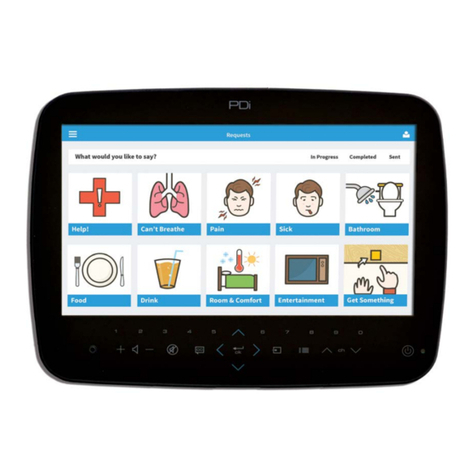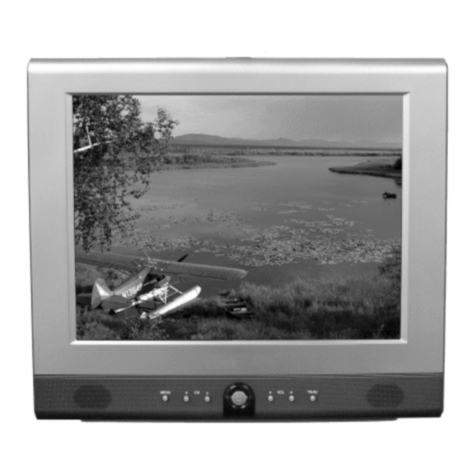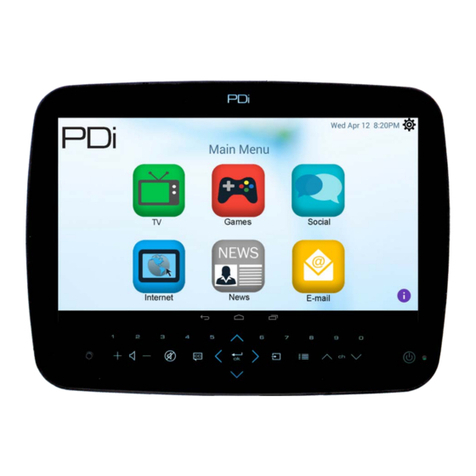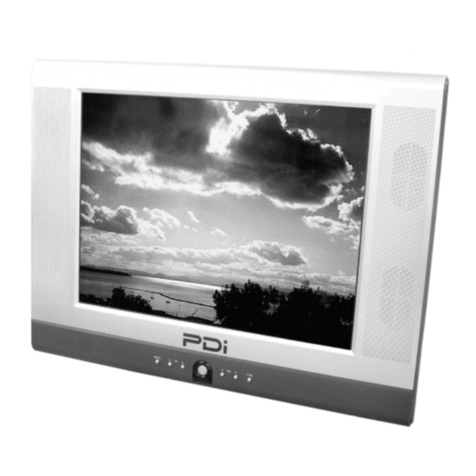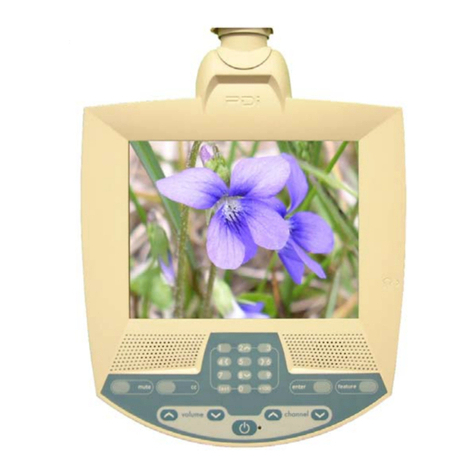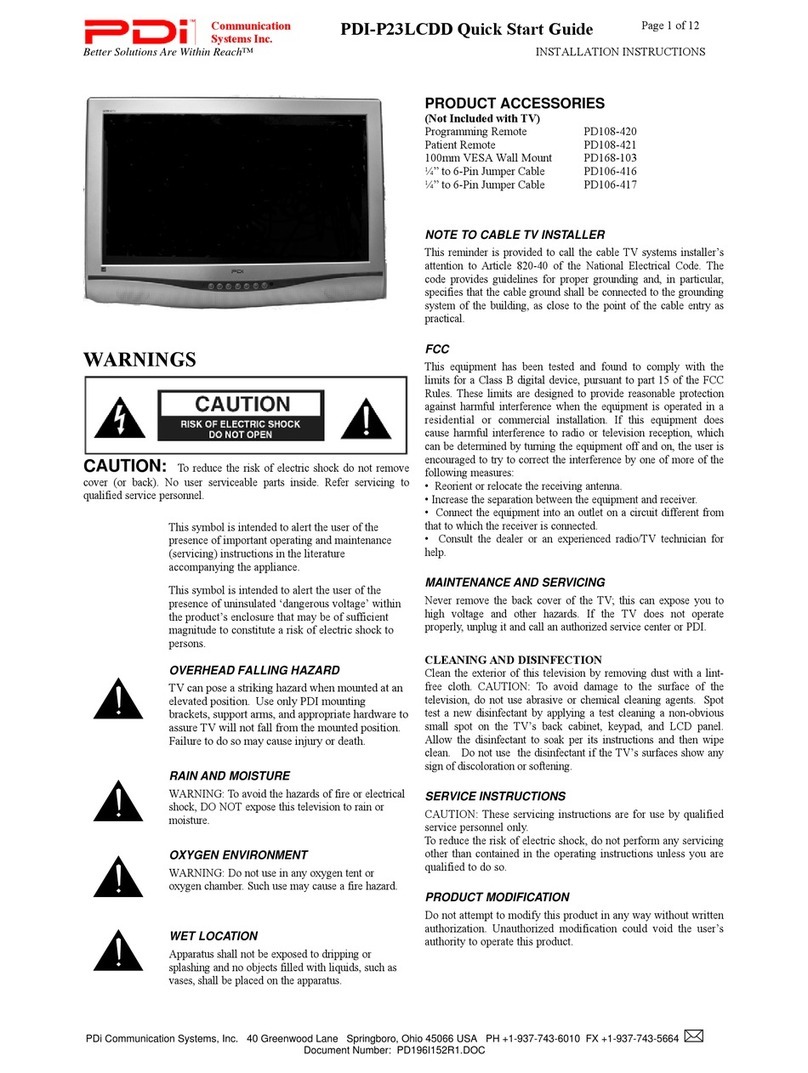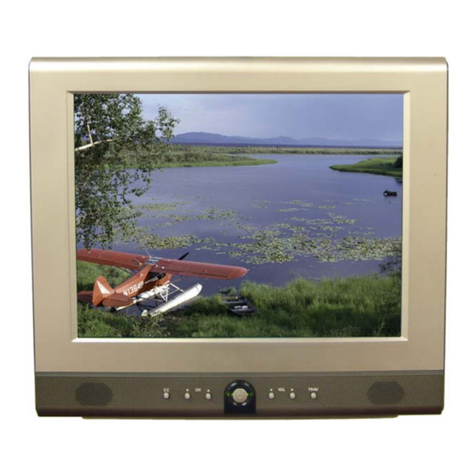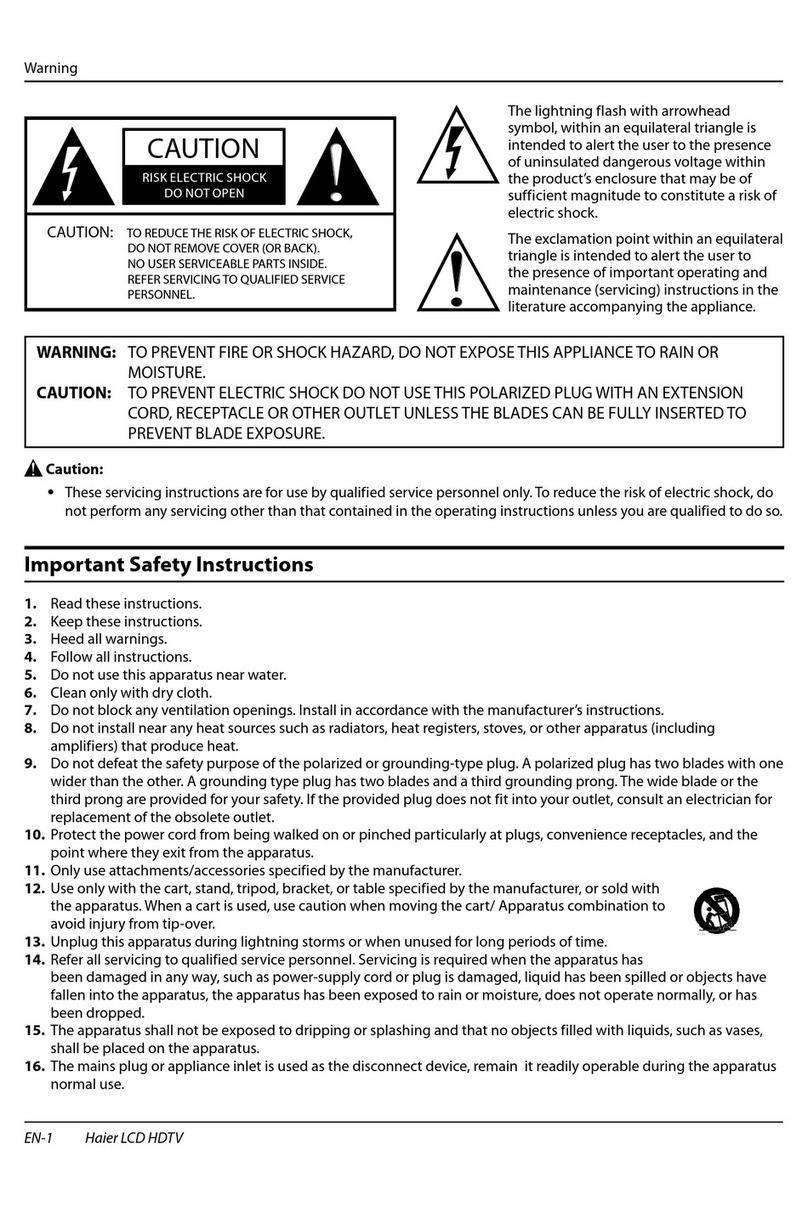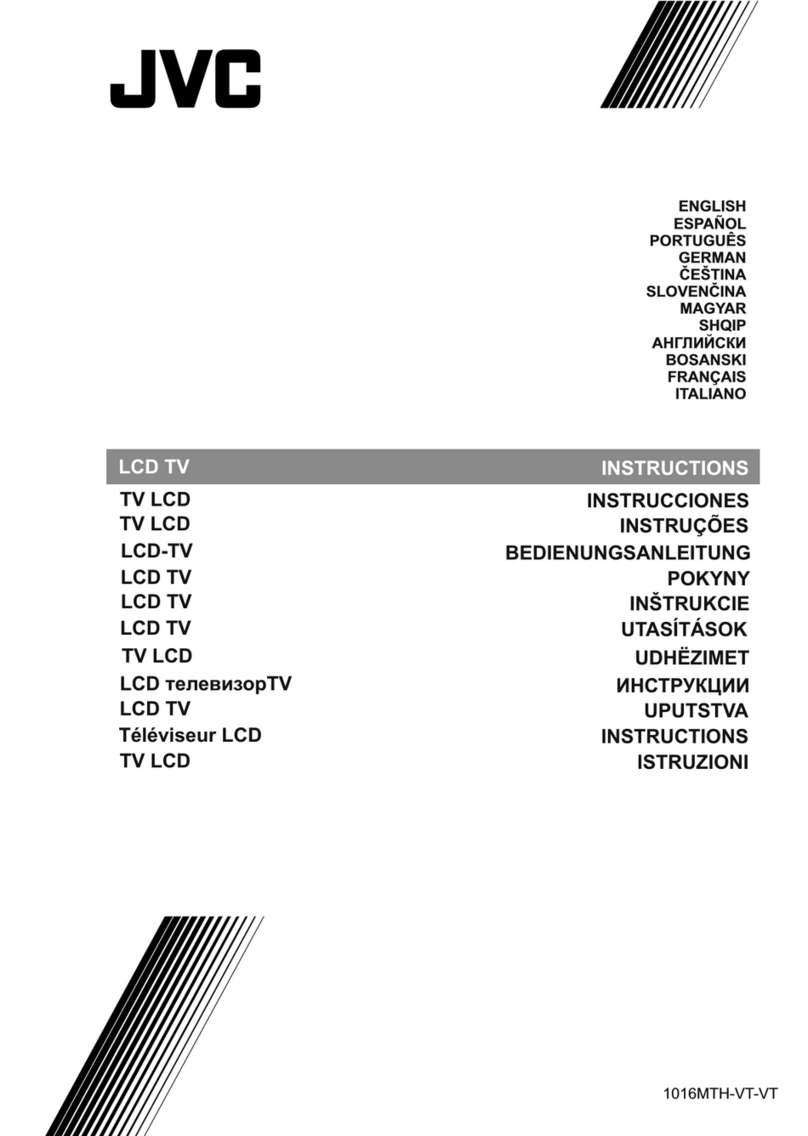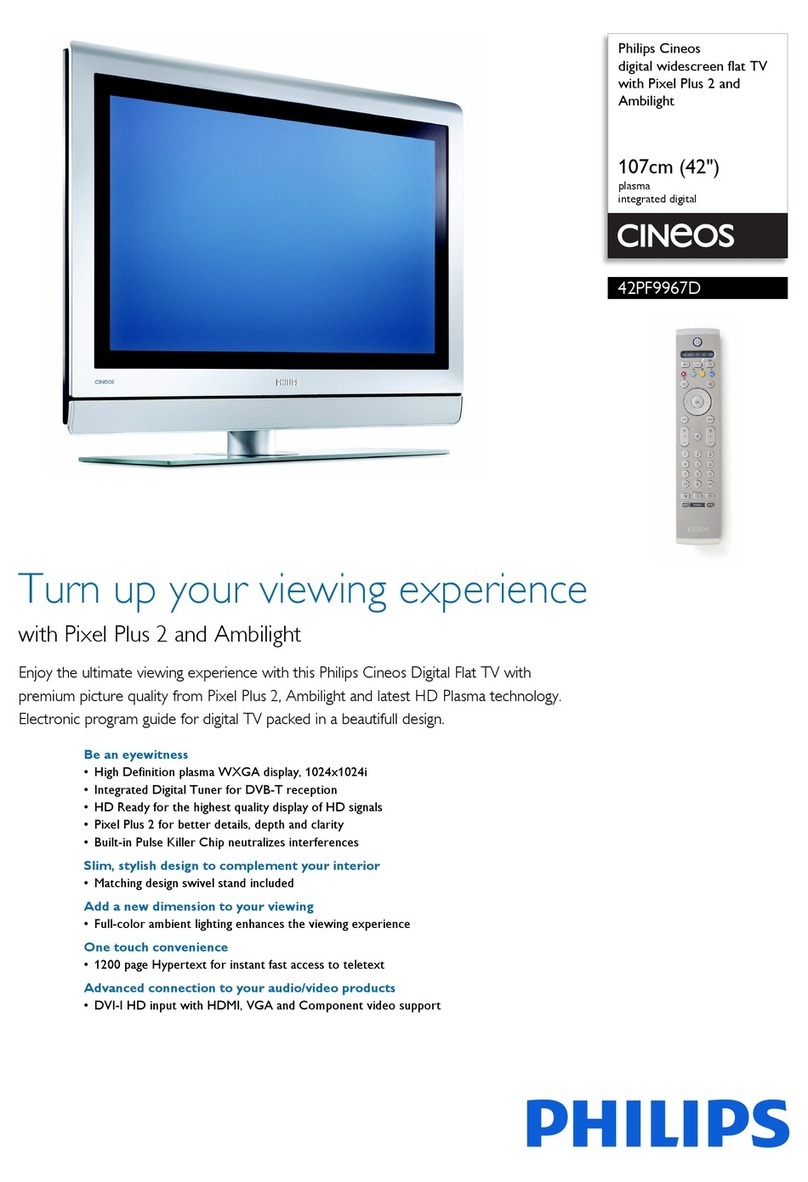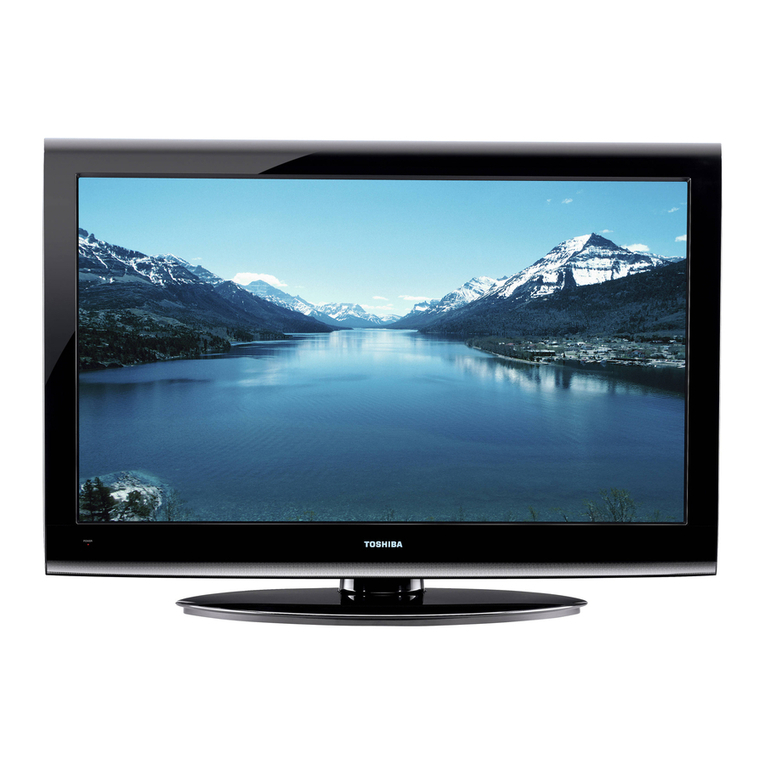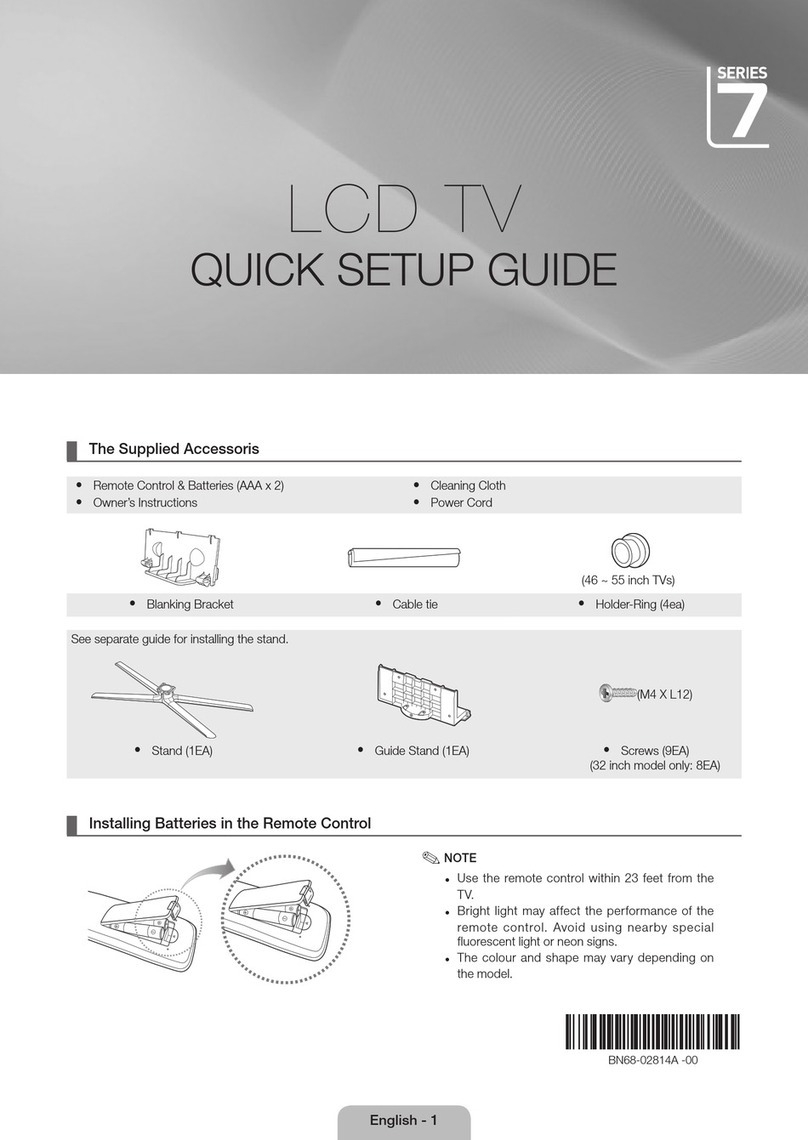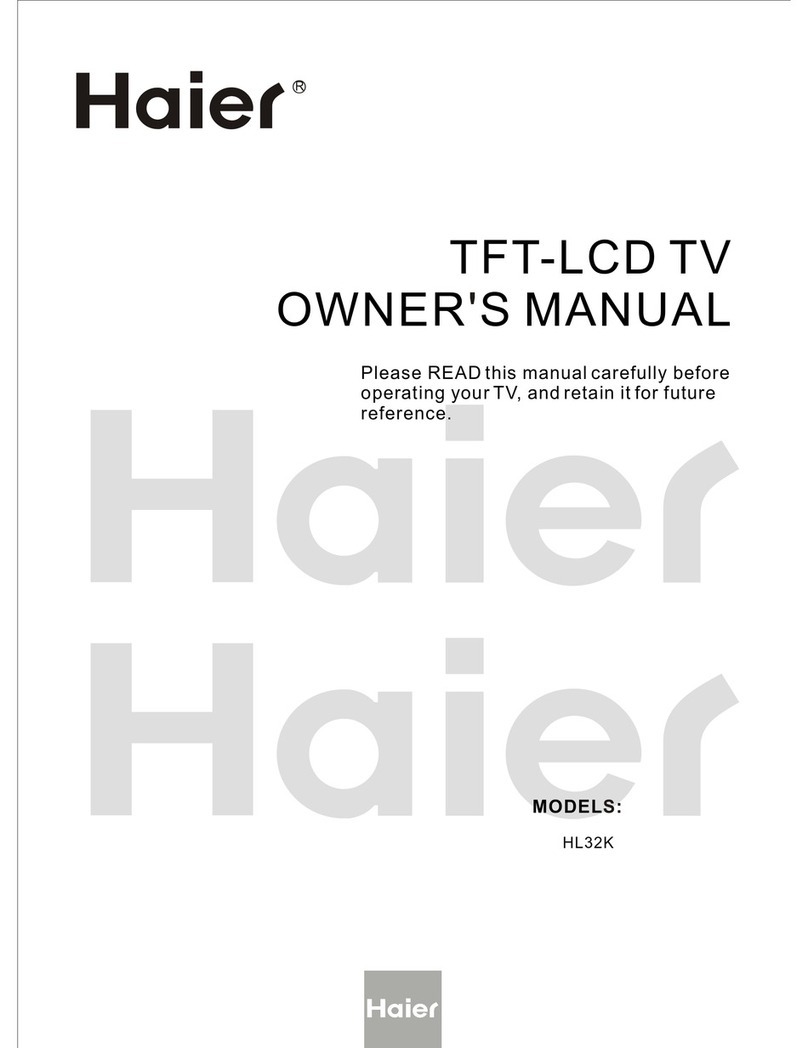PDi PDI-P15LCD User manual

PDI-P15LCD User Manual
Document Number: PD196-042R3
- 1 -
User
Manual
Communication
Systems, Inc.
40 Greenwood Lane
Springboro, Ohio
45066
PH: 937-743-6010
FX: 937-743-5664
http://www.pdiarm.com
Support Arm Mounted
Model PDI-P15LCD
LCD TV
Computer Monitor
Better Solutions Are Within Reachâ

PDI-P15LCD User Manual
Document Number: PD196-042R3
- 2 -
Warnings
WARNING
RISK OF ELECTRIC SHOCK
DO NOT OPEN
WARNING:
To reduce the risk of electric shock do not remove cover (or back). No
user serviceable parts inside. Refer servicing to qualified service
personnel.
This lightning flash with arrowhead symbol, within an equilateral is
intended to alert the user of the presence of uninsulated “dangerous
voltage” within the product’s enclosure that may be of sufficient
magnitude to constitute a risk of electric shock to persons.
The exclamation point within an equilateral triangle is intended to alert
the user of the presence of important operating and maintenance
(servicing) instructions in the literature accompanying the appliance.
NOTE TO CABLE TV INSTALLER
This reminder is provided to call the cable TV systems installer’s
attention to Article 820-40 of the National Electrical Code. The code
provides guidelines for proper grounding and , in particular, specifies that
the cable ground shall be connected to the grounding system of the
building, as close to the point of the cable entry as practical.
MAINTENANCE AND SERVICING
Never remove the back cover of the TV, this can expose you to high
voltage and other hazards. If the TV does not operate properly, unplug it
and call an authorized service center or PDI.
CLEANING AND DISINFECTING
Clean the exterior of this television by removing dust with a lint-free
cloth. CAUTION: To avoid damage to the surface of the television, do
not use abrasive or chemical cleaning agents.
RAIN AND MOISTURE
WARNING: To avoid the hazards of fire or electrical shock, DO NOT
expose this television to rain or moisture.
OXYGEN ENVIRONMENT
WARNING: Do not use in any oxygen tent or oxygen chamber. Such
use may cause a fire hazard.
SUPPORT DEVICE
The PDI-P15LCD requires a model PDI 400 or 500 series support arm
for mounting.

PDI-P15LCD User Manual
Document Number: PD196-042R3
- 3 -
PRODUCT MODIFICATION
Do not attempt to modify this product in any way without written
authorization. Unauthorized modification could void the user’s authority
to operate this product.
POWER
This set operates from a PDI-771-LCD power supply. The supply mounts
in the support arm wall bracket and provides a clean installation.
a. Connect the arm power cord that exits the base of the support
arm.
b. Connect the power cord to an AC outlet.
c. Connect the hospital CATV coax.
In the event of thunderstorms or power outages, please unplug the AC
plug from the wall outlet and unplug the cable TV coax. Do not allow
anything to rest upon or roll over the power cord, and do not place the
set where the power cord is subject to damage.
REGULATORY INFORMATION
FCC
This equipment has been tested and found to comply with the limits for a
Class B digital device, pursuant to part 15 of the FCC Rules. These
limits are designed to provide reasonable protection against harmful
interference when the equipment is operated in a residential or
commercial installation. If this equipment does cause harmful
interference to radio or television reception, which can be determined by
turning the equipment off and on, the user is encouraged to try to correct
the interference by one of more of the following measures:
• Reorient or relocate the receiving antenna.
• Increase the separation between the equipment and receiver.
• Connect the equipment into an outlet on a circuit different from
that to which the receiver is connected.
• Consult the dealer or an experienced radio/TV technician for
help.
Underwriters Laboratories
This device is safety tested and listed by the Underwriters Laboratories
as a product for use in both the United States and Canada.
CATV COAX

PDI-P15LCD User Manual
Document Number: PD196-042R3
- 4 -
IMPORTANT SAFETY INSTRUCTIONS
11. Only use attachments/accessories specified
by the manufacturer.
12. Use only with the cart,
stand, tripod, bracket or
table specified by the
manufacturer, or sold with
the apparatus. When a
cart is used, use caution
when moving the
cart/apparatus
combination to avoid
injury from tip-over.
1. Read these instructions.
2. Keep these instructions.
3. Heed all warnings.
4. Follow all instructions.
5. Do not use this apparatus near water.
6. Clean only with dry cloth.
7. Do no block any ventilation openings.
Install in accordance with the
manufacturer’s instructions.
8. Do not install near any heat source such
as radiators, heat registers, stove, or other
apparatus (including amplifiers) that
produce heat.
9. Do not defeat the safety purpose of the
hospital grounding-type plug. A hospital
plug has two blades and a third grounding
prong. The third prong is provided for
your safety. If the provided plug does not
fit into your outlet, consult an electrician
for replacement of the obsolete outlet.
10. Protect the power cord from being walked
on or pinched particularly at plugs,
convenience receptacles, and the point
where they exit from the apparatus.
13. Unplug this apparatus during lightning
storms or when unused for long period of
time.
14. Refer all servicing to qualified service
personnel. Servicing is required when the
apparatus has been damaged in any way,
such as power-supply cord or plug is
damaged, liquid has been spilled or objects
have fallen into the apparatus, the
apparatus has been exposed to rain or
moisture, does not operate normally, or has
been dropped.
Copyright, Disclaimer, and Trademarks
COPYRIGHT
PDI Communication Systems, Inc. claims proprietary right to the material disclosed in this user
manual. This manual is issued for user information only and may not be used to manufacture
anything shown herein. Copyright by PDI Communication Systems, Inc. All rights reserved.
DISCLAIMER
The author and publisher have used their best efforts in preparing this manual. PDI
Communication Systems, Inc. make no representation or warranties with respect to the accuracy
or completeness of the contents of this manual and specifically disclaim any implied warranties or
merchantability or fitness for any particular purpose and shall in no event be liable for any loss of
profit or any other damages. The information contained herein is believed accurate, but is not
warranted, and is subject to change without notice or obligation.
TRADEMARKS
All brand names and product names used in this manual are trademarks, registered trademarks,
or trade names of their respective holder. PDI and Better Solutions Are Within Reach are
registered trademarks of PDI Communication Systems, Inc., Springboro, Ohio.

PDI-P15LCD User Manual
Document Number: PD196-042R3
- 5 -
INSTALLATION
LOCATION GUIDELINES
The PDI-P15LCD TV is intended for entertainment purposes and should be installed in a non-
hazardous area in accordance with the National Electrical Code (NEC), ANSI/NFPA 70.
The PDI-P15LCD TV is designed to be mounted and supported on either a PDI 400 or 500 series
support arm. Select a location that is near a AC wall outlet and that does not expose the TV to
bright room lights or sunlight if possible.
CABLE SYSTEM GROUNDING
The coax cable system connected to the PDI-P15LCD TV should be grounded in accordance with
the National Electrical Code, ANSI/NFPA 70. The code provides guidelines for proper grounding
and, in particular, specifies that the cable ground shall be connected to the grounding system of
the building, as close to the point of the cable entry as practical.
SUPPORT ARM
The PDI-P15LCD is designed to mount to either 400 or 500 series support arm that is pre-strung
with an LCD power cable and RF coax cable. Computer display functionality requires an arm
pre-strung with a compatible VGA computer cable.
Attach Monitor to Arm
a. Fasten mounting plate “A” to mounting
channel “B” using (4) #10 flat washers
and (4) 10-32 nylock hex nuts
provided.
b. Connect the Antenna cable to the
“ANT.”
c. Connect the power cable to “DC 12V”.
d. For computer operation connect
computer VGA cable to “PC/DTV IN”
and audio cable to “PC AUDIO IN”.
Cable Cover
a. Position cable cover “C” into mounting
channel “B”.
b. Attach cable cover with (4) #8x32
screws.
A
B
C
B

PDI-P15LCD User Manual
Document Number: PD196-042R3
- 6 -
Align Bottom Cover
a. Insert studs “D” into slots “E”,
being careful to not pinch any
wires.
Attach Bottom Cover
a. Align (4) holes in “B” and “C”.
Install (4) 10-32 x 3/8 Phillips head
machine screws.
Power and Signal Connections
1. Connect the ARM POWER CABLE
that exits the base of the arm to the
power connector on the bottom of the
power supply.
2. Connect the CATV RF CABLE to the
hospital’s cable system.
3. Plug the AC Plug to the wall outlet.
E
D
AC PLUG
Wall Outlet
CATV RF
CABLE
ARM
POWER
CABLE

PDI-P15LCD User Manual
Document Number: PD196-042R3
- 7 -
REMOTE
BATTERY INSTALLATION
1. Pull the battery cover upward in the
arrow direction to remove.
2. Insert two “AAA” batteries. Observe
the correct polarity.
3. Replace the battery cover.
USING THE REMOTE
1. Make sure there are no objects between the remote control and its sensor.
2. Don’t store the remote control near a heater or damp place.
3. A strong impact to the remote control may cause damage and operational failure to the
remote.
4. Fluorescent lights, sunlight, or other strong light directed on the front of the TV may
interrupt the remote signal. In this case, position the TV away from the light in another
direction to restore operation of the remote control.
FUNCTIONS
All TV functions can be controlled using the remote control. Some functions can also be adjusted
with the buttons on the front panel of the set.
POWER
123
54 6
789
0
MENU TV/AV
ST/SAP
SLEEP Q.VIEW LIST
CH▲
CH▼
◄VOL VOL►
OK
PSM SSM PC/ *
CC
Sets the closed captions.
CH▼▲
Selects a next channel or a
menu item.
O
K
A
ccepts your selection or
displays the current mode.
MENU
Displays an on-screen menu
ST/SAP
A
djusts the MTS-Stereo, Mono,
Second Audio Program (SAP).
SSM(Sound Status Memory)
Recalls your preferred sound setting.
MEMOR
Y
Stores or deletes the current channel
from memory.
SLEEP
Sets the sleep timer.
V
OL◄►
A
djusts the sound level.
A
djusts menu settings.
TV/AV
Selects COMPONENT, VIDEO, S-VIDEO,
RADIO, PC, DTV, or TV mode. Clears the
menu from the screen.
Q.VIEW
Returns to the previously viewed
channel.
PSM(Picture Status Memory)
Recalls your preferred picture
setting.
MUTE
Turns the sound on or off.
ARC / *
CC MEMORY PC/*
Selects PC mode.

PDI-P15LCD User Manual
Document Number: PD196-042R3
- 8 -
Controls
1. MENU – Displays on screen menu. The Menu button can be disabled using the remote
control to prevent patient and visitor tampering – see the “Special” menu and “Childlock”
instructions elsewhere in this manual for details.
2. ▼CH ▲– Selects a TV channel or a MENU item when the on screen menu is active.
3. POWER – Turns the TV On and Off. Illuminates red when the TV is Off. Illuminates
green when the TV is On. Flashes when an IR remote control signal is detected by the
TV.
4. ◄VOL ►- Adjusts the internal TV speaker or headphone volume up or down. Also
adjusts a selected menu item when the on screen menu is active.
5. TV/AV – Selects either TV, COMPONENT, VIDEO, S-VIDEO, RADIO (only if Radio is
activated via the Setup Menu), PC or DTV modes. The TV/AV button can be disabled
using the remote control to prevent patient and visitor tampering – see the “Special”
menu and “Childlock” instructions elsewhere in this manual for details.
Connections
Connection Panel
The connection panel is located on the back of the TV and provides connections to external
equipment.
1. DC IN-12V – Power Input Jack.
2. PC/DTV IN – Computer VGA or DTV Input.
3. PC AUDIO IN – Audio input from PC.
4. COMPONENT DTV INPUT – Signal inputs for component video.
5. H/P – Headphone jack.
6. S-VIDEO – Input connection for S-Video signal.
7. A/V IN – Video and audio input jacks.
8. ANT – Hospital Cable TV Input.
▼CH ▲ ◄
V
OL ►MENU TV/AV
1 2 3 4 5
▲
A
NT.
▲
S-VIDEO
▲
H/P
▲
DC IN-12V
▲▲▲
VIDEO L(MONO)R
▲
PC/DTV IN
A
/V IN
▲▲▲▲▲
Y Cb Cr L(MONO) R
▲
PC
A
UDIO IN
1 2 3 4 5 6 7 8
COMPONENT DTV INPUT

PDI-P15LCD User Manual
Document Number: PD196-042R3
- 9 -
ANT.
Connect the hospital’s cable to this fitting.
CAUTION: Some hospital cable systems provide power voltage
on the coaxial cable. The P15LCD is NOT designed to be
powered over a coaxial cable. Do NOT connect to a powered
coaxial cable. Damage will result to the TV.
COMPONENT INPUT (DVD)
1. Connect the Video outputs (Y CB CR) on a DVD to the COMPONENT DTV INPUT of the
TV. Note: The cable and connectors are color coded – just match the colors.
2. Press the TV/AV button to select Component mode. The mode is displayed at the top
right of the screen. The TV/AV button can be disabled using the remote control to
prevent patient and visitor tampering – see the “Special” menu and “Childlock”
instructions elsewhere in this manual for details.
3. Press the PLAY button on the DVD.
DVD PLAYER
▲
A
NT.
▲
S-VIDEO
▲
H/P
▲
DC IN-12V
▲▲▲
VIDEO L(MONO)R
▲
PC/DTV IN
A
/V IN
▲▲▲▲▲
Y Cb Cr L(MONO) R
▲
PC
A
UDIO IN COMPONENT DTV INPUT
▲
A
NT.
▲
S-VIDEO
▲
H/P
▲
DC IN-12V
▲▲▲
VIDEO L(MONO)R
▲
PC/DTV IN
A
/V IN
▲▲▲▲▲
Y Cb Cr L(MONO) R
▲
PC
A
UDIO IN COMPONENT DTV INPUT

PDI-P15LCD User Manual
Document Number: PD196-042R3
- 10 -
S-VIDEO (VCR or DVD)
Many VCRs provide S-Video signals to provide improved picture quality.
1. Connect the S-VIDEO output of a VCR to the S-VIDEO input on the TV.
2. Connect the audio cables from the S-VIDEO VCR to the L(MONO) R A/V IN inputs of the
TV.
3. Select S-VIDEO mode by pressing the TV/AV button repeatedly. The TV/AV button can
be disabled using the remote control to prevent patient and visitor tampering – see the
“Special” menu and “Childlock” instructions elsewhere in this manual for details.
4. Press the PLAY button on the VCR.
A/V IN (VCR)
1. Connect the audio outputs from the VCR (L, R) to the A/V IN on the TV.
Connection is color coded.
2. Connect the video output from the VCR to the A/V IN on the TV.
Connections are color coded.
3. Select VIDEO mode by pressing the TV/AV button repeatedly.
The TV/AV button can be disabled using the remote control to prevent patient and visitor
tampering – see the “Special” menu and “Childlock” instructions elsewhere in this manual
for details.
4. Press the PLAY button on the VCR.
S-VIDEO VCR or DVD
▲
A
NT.
▲
S-VIDEO
▲
H/P
▲
DC IN-12V
▲▲▲
VIDEO L(MONO)R
▲
PC/DTV IN
A
/V IN
▲▲▲▲▲
Y Cb Cr L(MONO) R
▲
PC
A
UDIO IN COMPONENT DTV INPUT
▲
A
NT.
▲
S-VIDEO
▲
H/P
▲
DC IN-12V
▲▲▲
VIDEO L(MONO)R
▲
PC/DTV IN
A
/V IN
▲▲▲▲▲
Y Cb Cr L(MONO) R
▲
PC
A
UDIO IN COMPONENT DTV INPUT
VCR

PDI-P15LCD User Manual
Document Number: PD196-042R3
- 11 -
COMPUTER
The PDI-P15LCD is designed to also be used as a computer monitor. However, the support arm
must be pre-strung with a compatible VGA computer cable to utilize this feature.
1. Connect the VGA computer cable to the PC/DTV IN jack on the set.
2. Connect the PC Audio In cable from the PC to the PC AUDIO IN of the set.
3. Press the TV/AV button to select PC mode. The TV/AV button can be disabled using the
remote control to prevent patient and visitor tampering – see the “Special” menu and
“Childlock” instructions elsewhere in this manual for details.
4. Switch on the PC. The PC screen should appear on the set.
MODE RESOLUTION HORIZONTAL
FREQUENCY (Khz)
VERTICAL
FREQUENCY (Hz)
VGA
640x480
640x480
720x400
37.9 Khz
37.5 Khz
31.4 Khz
72 Hz
75 Hz
70 Hz
SVGA
800x600
800x600
800x600
800x600
35.1 Khz
37.9 Khz
48.1 Khz
46.9 Khz
56 Hz
60 Hz
72 Hz
75 Hz
XGA
1024x768
1024x768
1024x768
48.4 Khz
56.5 Khz
60.0 Khz
60 Hz
70 Hz
75 Hz
DTV
720 x 480p
720 x 576p
1280 x 720p
1280 x 720p
1920 x 1080i
1920 x 1080i
31.5 Khz
31.2 Khz
45.0 Khz
37.5 Khz
33.7 Khz
28.1 Khz
60 Hz
50 Hz
60 Hz
50 Hz
60 Hz
50 Hz
NOTE:
1. If the set is cold, there may be a small “flicker” when the set is switched ON.
This is normal, there is nothing wrong with the set.
2. Some dot defects may appear on the screen, like Red, Green or Blue spots. However,
this will have no impact or effect on the monitor performance.
COMPUTER
▲
A
NT.
▲
S-VIDEO
▲
H/P
▲
DC IN-12V
▲▲▲
VIDEO L(MONO)R
▲
PC/DTV IN
A
/V IN
▲▲▲▲▲
Y Cb Cr L(MONO) R
▲
PC
A
UDIO IN COMPONENT DTV INPUT

PDI-P15LCD User Manual
Document Number: PD196-042R3
- 12 -
DTV
1. Connect the PC in cable (D sub jack) from the DTV output of the DTV receiver to
PC/DTV IN of the TV.
2. Connect the Audio cable from the Audio output of DTV receiver of L(MONO) and R of the
set.
3. Press the TV/AV button to select DTV mode. The TV/AV button can be disabled using
the remote control to prevent patient and visitor tampering – see the “Special” menu and
“Childlock” instructions elsewhere in this manual for details.
4. Try this after turning on the DTV set.
NOTE: To receive the DTV program, it is necessary to purchase a DTV receiver (Set-top Box)
and connect it to the TV.
R AUDIO L H V R G B
R AUDIO L
OR
▲
A
NT.
▲
S-VIDEO
▲
H/P
▲
DC IN-12V
▲▲▲
VIDEO L(MONO)R
▲
PC/DTV IN
A
/V IN
▲▲▲▲▲
Y Cb Cr L(MONO) R
▲
PC
A
UDIO IN COMPONENT DTV INPUT

PDI-P15LCD User Manual
Document Number: PD196-042R3
- 13 -
MENUS
MENU TREE
The on screen menus are navigated by first pressing the MENU
button on the remote and then using the CH ▲▼ button to
select the desired menu.
Parental Control
TV Rating ►
MPAA Rating ►
Block Hour Always
Parental Lock ON
Change Password ►
Position: ▲▼ Next: ◄►
Back : MENU Exit : TV/AV
C
l
oc
k
Clock --:--
Off Time --:--
On Time --:--
On Program 1
Position: ▲▼ Adjust : ◄►
Back : MENU Exit : TV/AV
Setup
A
uto Program ►
Manual Program ►
Program List ►
Language ►
Position: ▲▼ Next: ◄►
Back : MENU Exit : TV/AV
Special
Clock ►
Blue Back Off
A
uto Sleep Off
Childlock Off
Radio Off
Caption Off
Parental Control ►
Position: ▲▼ Next: ◄►
Back : MENU Exit : TV/AV
Sou
n
d
Equalizer ►
Balance 0
A
VL Off
Surround Off
Sound Mode MONO
Position: ▲▼ Next: ◄►
Back : MENU Exit : TV/AV
Pi
ctu
r
e
Contrast 90
Brightness 75
Color 75
Sharpness 60
Tint 0
Position: ▲▼ Next: ◄►
Back : MENU Exit : TV/AV
MAIN MENU
Picture ►
Sound ►
Special ►
Setup ►
Position: ▲▼ Next: ◄►
Exit : TV/AV
Position: ▲▼ Confirm : OK
Back : MENU Exit : TV/AV
000 - - - - - 005 - - - - -
001 - - - - - 006 - - - - -
002 - - - - - 007 - - - - -
003 - - - - - 008 - - - - -
004 - - - - - 009 - - - - -
Program List
Position: ▲▼ Adjust : ◄►
Back : MENU Exit : TV/AV
Table Cable
Start
Auto Program
Position: ▲▼
Back : MENU Exit : TV/AV
English
Francais
Es
p
ańol
Language
Position: ▲▼ Next: ◄►
Back : MENU Exit : TV/AV
Channel 1
Table Cable
Edit Name ►
Ski
p
Off
Manual Program
Equalizer
Position: ▲▼ Adjust : ◄►
Back : MENU Exit : TV/AV
▄
▄▄▄▄
▄
▄▄▄▄
▄
▄▄▄▄
0.1 0.5 1.5 5.0 10Khz
Flat
Music
Movie
Speech
User

PDI-P15LCD User Manual
Document Number: PD196-042R3
- 14 -
Position: ▲▼ Adjust : ◄►
Back : MENU Exit : TV/AV
Table Cable
Start
Auto Program
Position: ▲▼ Next: ◄►
Back : MENU Exit : TV/AV
Channel 1
Table Cable
Edit Name ►
Ski
p
Off
Manual Program
Position: ▲▼ Confirm : ◄►
Back : MENU Exit : TV/AV
Station 02
-----
▲
▼
Edit Name
AUTO PROGRAM
Automatically memorizes all the receivable channels on a hospital’s cable TV system.
Press the MENU button on the remote.
1. Select the Setup menu.
2. Select Auto Program.
3. Press the CH▲▼ button and select Table.
4. Select the TV cable system in your hospital with the
VOL◄► button.
NOTE: Table = V/UHF is used for a cable system
that has a master antenna and usually can only
receive local TV Stations.
Table = Cable is used when a hospital cable system has both local and satellite TV
channels available. Table mode = Cable is most common in hospital TV systems.
5. Select the Start menu with the CH▲▼ button.
6. Press the VOL◄► button to start Auto Programming. The TV will now search all
available channels looking for signals and memorizing those channels that are active.
Occasionally, strong over-the-air stations sneak onto the cable system. To remove
unwanted channels see Manual Program.
7. Press the MENU button to finish auto programming.
8. Press the TV/AV button to return to normal TV viewing.
HINTS
• Press the CH▲▼ buttons to check the memorized channels after auto programming is
finished.
• If you press the MENU button during auto programming, the function will stop and only
channels programmed up to that point in time will remain.
• The auto programming function can memorize only those channels which are active at the
time of programming. For example, a hospital educational channel may not be actively
playing a tape and would not be memorized using auto program. See the Manual Program
section for adding and deleting channels.
MANUAL PROGRAM
Manual Program allows you to manually add or delete
channels.
1. Tune to the channel you wish to add or delete.
Press the MENU button.
2. Select the Setup menu.
3. Select the Manual Program menu.
4. Press the CH▲▼ buttons to select Channel.
Verify the TV is tuned to the desired channel. If
not, enter the channel number on the remote’s
keypad. Adjusting Table changes the current
tuning scheme. Usually Table does not require adjustment.
5. Select Skip On or Off with the CH▲▼ buttons. With Skip Off, the current channel will
be stored into the TV’s memory and made available for viewing by the patient. With Skip
On, the current channel will be removed from the TV’s memory and not be available for
viewing by the patient. However, the deleted channel can still be viewed by directly
entering the channel’s number using the remote’s
keypad.
6. Select Edit Name to add a Name description of
the channel. For example the Name “FOX” may
be added and displayed next to a specific channel.
Press the TV/AV button to return to normal TV
viewing.

PDI-P15LCD User Manual
Document Number: PD196-042R3
- 15 -
Pi
ctu
r
e
Contrast 90
Brightness 75
Color 75
Sharpness 60
Tint 0
Position: ▲▼ Next: ◄►
Back : MENU Exit : TV/AV
PROGRAM LIST
Program List shows a display of the Programmed Channels stored in the TV’s memory. Direct
tuning of a specific channel is possible.
1. Press the MENU button.
2. Select the Setup menu.
3. Press the CH▲▼ button select Program List.
4. To select a channel in on the Program List, use the CH▲▼ or VOL◄► buttons. The
set switches to the chosen channel number.
Picture
You can adjust picture Contrast, Brightness, Color, Sharpness and Tint to the levels you prefer
using the on screen menus or select PDI factory preset picture modes using the remote control.
USER PICTURE CONTROL
1. Press the MENU button.
2. Select the Picture Menu.
3. Press the CH▲▼ button to select a picture item.
4. Press the VOL◄► button to adjust the picture
item to the desired level.
5. Press the TV/AV button to store the picture
values in the User mode.
PSM – PICTURE STATUS MEMORY
1. Press the PSM button on the remote to view the current picture mode.
2. Press the PSM button repeatedly to select another PSM setting. The PSM setting will
cycle and the picture’s factory parameter settings will change accordingly.
Dynamic →Standard →Mild →Game →User
Dynamic Vivid Picture Appearance
Standard Standard Picture Appearance
Mild Softer Picture Appearance
Game External Video Game Appearance
User Manual Picture Setup
3. Press the OK button on the remote to select the currently displayed picture mode.

PDI-P15LCD User Manual
Document Number: PD196-042R3
- 16 -
Sou
n
d
Equalizer ►
Balance 0
A
VL Off
Surround Off
Sound Mode MONO
Position: ▲▼ Next: ◄►
Back : MENU Exit : TV/AV
Equalizer
Flat
Music
Movie
Speech
User
Position: ▲▼ Adjust : ◄►
Back : MENU Exit : TV/AV
▄
▄▄▄▄
▄
▄▄▄▄
▄
▄▄▄▄
0.1 0.5 1.5 5.0 10Khz
Sound
You can adjust the sound using Equalizer levels via the on
screen menus or select PDI factory preset sound modes using
the remote control.
EQUALIZER
1. Press the MENU button on the remote.
2. Select the Sound menu.
3. Press the CH▲▼ button and select Equalizer.
A listing of available frequency bands and current
settings will be displayed. The Flat, Music, Movie, and
Speech settings are factory preset sound modes and can
not be adjusted. Select User to adjust and customize the
sound equalization.
4. Press the VOL◄► button to select the desired sound
band.
5. Press the CH▲▼ button to adjust the strength of sound
for that particular sound band. Alternately, press
VOL◄► to select the next desired sound band and
adjust with the CH▲▼ button.
6. Press the MENU button to return to the preceding Menu
and the TV/AV button to return to normal TV viewing.
AUTO SOUND CONTROL (SSM)
Selection of the factory preset sound modes and user mode is available directly using the remote
control.
1. Press the SSM button to display the current Sound Equalizer setting.
2. Press the SSM button repeatedly to advance and select a different equalizer setting.
Flat →Music →Movie →Speech →User
3. Press the OK button to accept the current selection.
BALANCE
Adjusts the sound balance from the left and right speakers mounted in the TV.
1. Press the MENU button.
2. Select Sound from the menu.
3. Press the CH▲▼ button and select Balance.
4. Press VOL◄► to adjust the sound balance from the TV.
5. Press the MENU button to return to the preceding Menu and the TV/AV button to return
to normal TV viewing.
AVL
Automatic Volume Level control is available through this setting. With the AVL set to On, the
TV’s volume will be limited to one loudness. This feature prevents sound blasting during
commercials.
1. Press the MENU button.
2. Select Sound from the menu.
3. Press the CH▲▼ button and select Balance.

PDI-P15LCD User Manual
Document Number: PD196-042R3
- 17 -
Special
Clock ►
Blue Back Off
A
uto Sleep Off
Childlock Off
Radio Off
Caption Off
Parental Control ►
Position: ▲▼ Next: ◄►
Back : MENU Exit : TV/AV
Clock
Clock --:--
Off Time --:--
On Time --:--
On Program 1
Position: ▲▼ Adjust : ◄►
Back : MENU Exit : TV/AV
4. Press VOL◄► to adjust the sound balance from the TV.
5. Press the MENU button to return to the preceding Menu and the TV/AV button to return
to normal TV viewing.
SURROUND
Surround sound is available through this setting. With the Surround set to On, the TV’s audio is
processed and provides an added dimension to listening.
1. Press the MENU button.
2. Select Sound from the menu.
3. Press the CH▲▼ button and select Surround.
4. Press VOL◄► to turn the Surround On or Off.
5. Press the MENU button to return to the preceding Menu and the TV/AV button to return
to normal TV viewing.
SOUND MODE
You can select the type of sound generated by the television.
1. Press the MENU button.
2. Select Sound from the menu.
3. Press the CH▲▼ button and select Sound Mode.
4. Press VOL◄► to select the type of sound generated by the television TV.
Stereo Discrete left and right audio channels heard through
both the left and right TV speakers.
Mono Single channel of sound heard through both the left
and right TV speakers.
SAP Secondary Audio Program – Used for Bi-lingual
programs. Note: The viewed program channel must be
encoded with a SAP signal for this mode to work.
5. Press the MENU button to return to the preceding Menu and the TV/AV button to return
to normal TV viewing.
Alternately, the type of sound can be set using the remote control’s ST/SAP button.
Special
This menu provides access to
special functions.
CLOCK
Setting the clock is necessary
to use the various timer
features of the TV. NOTE:
The TV does not provide a
visible on-screen Clock display.
1. Press the MENU button.
2. Select the Special menu.
3. Press the CH▲▼ button to select Clock.
4. Press the VOL◄► button to select the Clock menu.
5. Set the present time with the number buttons and the CH▲▼ button on the remote
control. Set a time value between 00:00 … 23:59 (hours: minutes).
6. Press the CH▲▼ button.

PDI-P15LCD User Manual
Document Number: PD196-042R3
- 18 -
FM WIZH
Mode: Auto
STEREO 89.9 MHz
Equalizer:
FLAT
7. Press the TV/AV button to return to normal TV viewing.
Hints: Off and On times can also be set that allow the TV to turn OFF at a specified time or ON at
a specified time to a specified On Program channel.
BLUE BACK
Channels that are empty without any signal will be expressed as a blue screen rather than a
snowy picture.
8. Press the MENU button.
9. Select the Special menu.
10. Press the CH▲▼ button to select Blue Back.
11. Press the VOL◄► button to select On.
Press the TV/AV button to return to normal TV viewing.
AUTO SLEEP
If you select Auto Sleep = On, the set will automatically switch itself Off approximately ten
minutes after a TV channel stops broadcasting.
1. Press the MENU button.
2. Select the Special menu.
3. Press the CH▲▼ button to select Auto Sleep.
4. Press the VOL◄► button to select On.
5. Press the TV/AV button to return to normal TV viewing.
CHILDLOCK
Childlock disables the television’s MENU and TV/AV buttons and prevents patient and visitor
tampering with the TV. Once a TV is Childlocked, the only way to gain access to the MENU or
TV/AV controls is by using the remote control.
1. Press the MENU button.
2. Select the Special menu.
3. Press the CH▲▼ button to select Childlock.
4. Press the VOL◄► button to select On.
5. Press the TV/AV button to return to normal TV viewing.
RADIO
You can listen to FM radio stations that are included on the cable system. To use the radio, the
Childlock feature must be off to enable the TV/AV button.
1. Press the TV/AV button until RADIO shows in the mode title
at the top right of the screen. A user display shows the
current tuned station.
2. Press the CH▲▼ buttons to select a different station.
3. Exit the radio mode at any time by pressing TV/AV.
4. To program a station press the MENU button to display the
Radio Setup menu.
5. Press the CH▲▼ buttons to select Auto Program.
6. Press the VOL◄► button to start auto programming. The
TV will now search all available FM stations looking for
signals and memorizing those stations that are active.
7. To remove an unwanted station tune to the offending
station. Press the CH▲▼ buttons to select Delete.
8. Press the VOL◄► button to delete the current Channel.
9. To add a channel select Frequency. Press the VOL◄►
button to tune the desired FM station.
10. Press the CH▲▼ buttons to select Memorize. Press the
VOL◄► button to add the station.
11. Exit the Radio Setup menu at any time by pressing the TV/AV button.
Radio Setup
Mode Auto
Frequency 89.9 MHz
Programme 0
Memorize
Delete
A
uto Program ►
Off Time
Edit Name
Position: ▲▼ Next: ◄►
Back : MENU Exit : TV/AV

PDI-P15LCD User Manual
Document Number: PD196-042R3
- 19 -
Position: ▲▼ Adjust : ◄►
Back : MENU Exit : TV/AV
G U
PG U
PG-13 U
R U
NC-17 U
X U
No Rating U
MPAA Rating
CAPTION
Captions is a process which converts the audio portion of a television program into written words
which than appear on the television screen in a form similar to subtitles. Closed captions allow
viewers to read the dialogue and narration of TV programs.
To activate Closed Captioning:
1. Press the MENU button.
2. Select the Setup menu.
3. Press the CH▲▼ buttons to select the Caption menu.
4. Each time you press the VOL◄► button, the caption mode is displayed one by one as
show below.
OFF →CC1 →CC2 →CC3 →CC4
TEXT4 ←TEXT 3 ←TEXT2 ←TEXT1
5. Press the TV/AV button to exit and return to normal TV viewing.
Alternately, the captions can be set using the remote control’s CC button.
• Closed captions will only appear if the TV program has been encoded with closed
captioning information.
• Text modes may display a solid black box in the center of the TV’s screen when
activated.
• CC1 is the most common closed caption setting.
Parental Control
A parental control feature is available to restrict or block
undesirable programs from appearing on the TV. This feature is
of particular importance for TVs installed in pediatric wards.
1. Press the MENU button.
2. Select the Special menu.
3. Press the CH▲▼ button to select the Parental Control
menu, then press VOL◄►.
4. If a password has been entered a Enter Password
menu will appear. NOTE: the default password for a
new TV is “0000”. After entering a valid password, the
Parental Control menu will appear.
5. Use the VOL◄► and CH▲▼ button to select and
adjust or set the rating for the TV or MPAA.
6. Press the VOL◄► buttons to select the TV Rating.
Then press the CH▲▼ buttons to move to one of the
six age-based categories in the column and press the
VOL◄► buttons to move to one of the levels in each
row.
7. At this point, one of the TV-Ratings is selected. Press
the CH▲▼ buttons. Depending on your existing setup,
a letter “U” or “B” will be highlighted. (U=Unblocked,
B=Blocked)
8. While the “U” or “B” is highlighted, press the VOL◄►
buttons to block or unblock the category. To select a different TV-Rating, press the
CH▲▼ buttons with the cursor in the first column.
Position: ▲▼ Adjust : ◄►
Back : MENU Exit : TV/AV
All FV V S L D
TV-Y U
TV-Y7 U U
TV-G U
TV-PG U U U U U
TV-14 U U U U U
TV
-
MA U UUU
TV Rating

PDI-P15LCD User Manual
Document Number: PD196-042R3
- 20 -
9. Press the VOL◄► buttons to select the MPAA Rating. Then press the CH▲▼ buttons
to select particular MPAA Ratings. While a particular category is selected, press the
VOL◄► buttons to activate it. A highlighted letter (“U” or “B”) will be displayed. Press
the CH▲▼ buttons to change the setting.
10. If you wish to change the password, select the Change Password menu.
11. Enter your new password by re-entering the same 4 digits. Press the OK button to
memorize your new password.
MOTION PICTURE ASSOCIATION OF USA (MPAA) RATING SYSTEM
Grade Meaning
G General Audiences Content not offensive to most viewers
PG Parental Guidance
Suggested
Content is such that parents may not want their children to view the
program.
PG-13 Parental Guidance
suggested
Program is inappropriate for preteens, with a greater degree of
offensive material suggested than a PG rated program
R Restricted Viewing Not for children under age 17. Strong elements of sex and/or
violence.
NC-17 Restricted Viewing Not for children under age 17 under any circumstances. Strong
sexual content.
X Hard Core Films Same as NC-17 rating.
No Rating No Rating MPAA Not Rated
TV PARENTAL GUIDELINE RATING SYSTEM
Grade Meaning
TV-Y General Audience Considered suitable for all children under 7 years old.
TV-Y7 Children 7 and over Considered suitable for children over 7, may contain Fantasy
Violence Scenes.
TV-G Parental Guideance Considered suitable for all audiences; children may watch
unattended
TV-PG Parents Strongly
Cautioned
Suggested Unsuitable for younger children, may contain:
Suggestive Dialog, Bad Language, Sex, and Violence Scenes.
TV-14 Parents Strongly
Cautioned
Unsuitable for children under 14, may contain: strong Dialog, bad
Language, Sex, and Violence Scenes.
TV-MA Mature Audience Only Adults only, may contain: strong Dialog, bad Language, Sex, and
Violence Scenes.
Hints for Setting Parental Control
• Determine which rating you consider acceptable to the viewer. For example, if you choose
TV-PG, all the more restrictive ratings will be automatically blocked; the viewer will not be
able to see TV-PG, TV-14, or TV-MA rated programming.
• Do you want to block the auxiliary video source entirely? When Aux is set to Block the signal
sent by equipment such as a VCR or DVD connected to the A/V IN input jacks will not be
available.
• How many hours do you want Parental Control to be active? You can set the hours option for
up to 99 hours.
• Select a secret password in the Set Password option. Use the number keys on the remote.
Don’t forget the password, it is the only way you can access the parental control menu and
change rating selections, or turn Parental Control off.
• Do you want Parental Control to be active all the time? If not, you can turn it on or off with
the Childlock On/Off option.
• You can set different Parental Control viewing restrictions for general audiences and for
children, both can be active at the same time.
• Simply specifying one content block such as Sex Scenes will not automatically block another
content in the programs form appearing.
• Even if you choose to leave the Aux inputs unblocked, the ratings you specify will
automatically restrict the program that appears from the video sources.
• You cannot disable Parental Control by disconnecting the TV from power. Block hours will
automatically reset to the original block time setting specified if power is disconnected.
Table of contents
Other PDi LCD TV manuals





